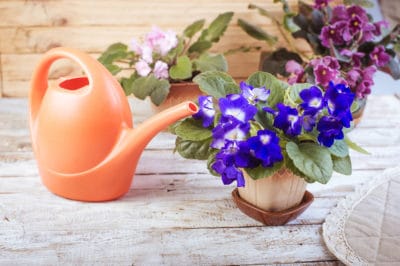The Violet That’s Not a Violet
Although it looks like true violets (family Violaceae), the Africa violet is actually a member of the Gesneraicae family. Correctly called a Saintpaulia, it is a perennial flowering plant that is native to Tanzania and Kenya in Africa. Grown as houseplants, they can also become outdoor plants if given just the right conditions. In warm summer areas, they can go outside for part of the year.
African Violet Varieties
African violets are available in a wide array of flower types, sizes and colors. Among the 40,000-plus available varieties:
- Paul Bunyan – double, star-shaped flowers in raspberry.
- Red Wax – fuchsia flowers and strawberry-like foliage.
- Confection – pastel pink flowers edged with pale green frills.
- Persian Brocade – pink flowers and variegated foliage.
- Adena – white flowers edged with frills of lavender.
Growing African Violets Outside
Native to wooded tropical forests where they live in shaded conditions, Africa violets absolutely cannot tolerate hot bright sun. A lightly shaded porch may be a good place for them in the right climate. It’s not a good idea to place them directly in the garden in most areas, as they are highly subject to insect attacks. They are hardy only in USDA Zones 11 and 12.
Watering African Violets
African violets should have enough water to keep the soil moist but not soggy. A self-watering device may be a useful tool when you are growing African violets. These plants are very susceptible to cold, so water should always be room temperature. Do not use water than has been softened or that contains chlorine. Don’t allow water to get on the leaves in sunlight as it can damage them.
Humidity Matters
In addition to watering the plants, give some consideration to humidity. Remember these plants come from the humid tropics, so overheated houses with low humidity can cause problems. Put the pots on trays filled with pebbles and pour water in the tray. You can also mist the plants, but make sure it’s a fine mist to prevent leaf damage.
Soil for African Violets
African violets are vulnerable to soil-borne diseases. You can pasteurize your potting soil by heating it to 180°F (82°C) and holding it at that temperature for 30 minutes. Commercial soils may already be pasteurized. A good potting soil for African violets is usually made primarily from sphagnum peat moss with the addition of perlite or vermiculite to promote drainage. The pH should be between 5.8 and 6.2.
Fertilizing African Violets
Commercial African violet food is a good choice for fertilizer – organic fertilizer is available. A formula of 14-12-14 NPK is usually recommended, although miniature plants grown in two-inch pots should have 7-9-5 NPK. Make sure the fertilizer does not contain urea, which can burn the plants. African violet fertilizer should always be 100 percent water-soluble to promote absorption. In addition, completely soluble fertilizers can be used in self-watering systems.
Light for African Violets
Bright but indirect light is best for African violets. When light is inadequate, the leaves will begin to turn yellow and the plant will stop flowering. Too much light can burn leaves, causing brown spots. West and south-facing windows provide lots of light but you should always provide a curtain or blind to filter the direct sunlight. African violets also need eight hours of darkness each day.
When an African Violet Won’t Bloom
Inadequate light is the most common reason for poor bloom. In winter, you may need to supplement natural daylight with grow lights for best blooming. Put the lights on a timer to ensure adequate darkness as well. Make sure you are watering correctly. African violets that are root bound will not bloom well, so repot as necessary. Finally, you may need to use a bloom booster fertilizer, which should be 12-36-14 NPK.
Repotting African Violets
Like most indoor plants, African violets should be repotted once a year. They actually prefer slightly tight quarters, so follow this rule: the plant should be three times the diameter of the pot. Place the plant at the same depth as before and trickle in potting soil. Don’t tamp down soil, just tap the pot lightly on the counter to settle the soil. Water well after repotting.
